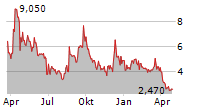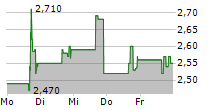New in vitro results show Telomir-1 adds KDM5 family inhibition to its previously reported KDM2/KDM6 and DNA methylation activity, potentially representing a novel frontier in epigenetic therapy where no existing candidates have shown comparable breadth.
MIAMI, FLORIDA / ACCESS Newswire / September 18, 2025 / Telomir Pharmaceuticals, Inc. (NASDAQ:TELO), a preclinical-stage biotechnology company developing therapies that target the root causes of cancer, aging, and age-related diseases, today announced new in vitro pharmacology results demonstrating that Telomir-1 potently inhibits three members of the KDM5 histone demethylase family.
Histone demethylases are upstream gene regulators that cancers exploit to silence tumor suppressors and activate inflammatory programs. Blocking these enzymes has long been viewed as scientifically important but clinically challenging, with KDM5 often described as challenging for development
Why This Matters
Cancer and aging are driven in part by the silencing of protective genes that regulate cell growth, repair, and survival. When these genes are inactive, cells lose critical defenses, enabling tumors to expand and age-related decline to progress.
This silencing occurs through two major mechanisms:
Histone demethylases (the switches):
Members of the KDM5 family are frequently overactive in cancers. Their role is to erase the "on" marks from tumor suppressor genes. When members of the KDM5 family do this, critical genes that normally stop uncontrolled cell growth, repair damage, or trigger cell death are effectively turned off - leaving cancer cells free to divide and accumulate mutations. KDM5 family members are mainly involved in cell cycle progression, stemness, and cancer drug resistance.
Members of the KDM2 and KDM6 families work differently. They remove "off" marks from genes that drive inflammation and cell proliferation. While KDM2 family members are mainly involved in gene repression or silencing, often linked with chromatin remodeling and some anti-cancer effects, the KDM6 family members are known for promoting gene activation which is tightly associated with developmental processes, inflammatory responses, and cancer subtype determination
Together, these enzymes push the balance in the wrong direction: shutting down the genes that protect cells while activating the ones that promote disease.
DNA methylation (the locks):
After histone changes switch genes off, a second layer of control reinforces the silence through DNA methylation.
This process involves adding small chemical tags (methyl groups) directly onto the DNA near gene promoters.
When these tags accumulate, the gene is no longer accessible to the cell's transcription machinery - in effect, the gene is shut down.
Importantly, these methylation patterns are copied every time a cell divides, which means the silence is passed on from one generation of cells to the next.
In cancer, this permanently disables tumor suppressor genes like CDKN2A and STAT1, removing critical brakes on cell growth and immune defense.
In aging, widespread changes in DNA methylation contribute to epigenetic drift - the gradual loss of normal gene regulation that underlies tissue decline and age-related disease.
Telomir-1 has now demonstrated the potential to reset both layers of control:
In the new in vitro studies, Telomir-1 potently inhibited three members of the KDM5 family, blocking the silencing of protective genes and preventing the activation of harmful inflammatory pathways.
Telomir-1 previously demonstrated activity across other families of histone demethylases, including UTX (KDM6A), JMJD3 (KDM6B), FBXL10 (KDM2B), and FBXL11 (KDM2A). These enzymes are associated with cancer progression, stemness, immune evasion, and age-related decline. Telomir-1 was also shown to spare broad acetyltransferases such as GCN5L2, which are associated with systemic toxicity when inhibited.
In other previously reported in vivo prostate cancer studies, Telomir-1 reduced abnormal DNA methylation and reactivated tumor suppressors such as CDKN2A and STAT1, with greater activity than chemotherapy and rapamycin.
By acting at both the histone and DNA levels, Telomir-1 is emerging as a first-in-class, broad-spectrum epigenetic reset therapy with the potential to restore fundamental cellular defenses relevant to cancer and aging.
"This is a breakthrough," said Erez Aminov, Chief Executive Officer of Telomir. "Telomir-1 is demonstrating the potential to create an entirely new class of treatments aimed at the root biology of cancer, aging, and other serious diseases."
"Showing that Telomir-1 can potently inhibit several family members of three types of histone demethylases, known to present drug discovery challenges such as selective targeting, cellular permeability, and context-dependent effects, is highly significant," added Dr. Itzchak Angel, Chief Scientific Advisor at Telomir. "It suggests a new path for tackling how cancers silence protective genes and how aging erodes cellular defenses."
Taken together, Telomir-1 demonstrates an unusually broad impact across both DNA methylation and histone demethylation pathways - the fundamental axes of epigenetic control.
Advancing Toward the Clinic
Telomir continues to advance IND-enabling studies and GMP scale-up for Telomir-1, with additional preclinical evaluations ongoing across aggressive cancers and models of aging. The Company expects these findings to support its upcoming IND submission.
About Telomir Pharmaceuticals
Telomir Pharmaceuticals, Inc. (NASDAQ: TELO) is a preclinical-stage biotechnology company developing small-molecule therapies that target the root causes of cancer, aging, and age-related diseases by resetting dysregulated epigenetic programs. The Company's lead candidate, Telomir-1, is being advanced across oncology and longevity indications based on its differentiated ability to restore tumor suppressors, block undruggable enzymes, and reprogram gene control. For more information, visit www.telomirpharma.com.
Cautionary Note Regarding Forward-Looking Statements
This press release, statements of Telomir's management or advisors related thereto, and the statements contained in the news story linked in this release contain "forward-looking statements," which are statements other than historical facts made pursuant to the safe harbor provisions of Section 27A of the Securities Act of 1933, as amended, and Section 21E of the Securities Exchange Act of 1934, as amended. These risks and uncertainties include, but are not limited to, the potential use of the data from our studies, our ability to develop and commercialize Telomir-1 for specific indications, and the safety of Telomir-1.
Any forward-looking statements in this press release are based on Telomir's current expectations, estimates and projections only as of the date of this release. These and other risks concerning Telomir's programs and operations are described in additional detail in its Annual Report on Form 10-K for the fiscal year ended December 31, 2024, which are on file with the SEC and available at www.sec.gov. Telomir explicitly disclaims any obligation to update any forward-looking statements except to the extent required by law.
Contact Information
Helga Moya
info@telomirpharma.com
(786) 396-6723
SOURCE: Telomir Pharmaceuticals, Inc
View the original press release on ACCESS Newswire:
https://www.accessnewswire.com/newsroom/en/healthcare-and-pharmaceutical/telomir-pharmaceuticals-announces-in-vitro-data-showing-telomir-1-tar-1075185


